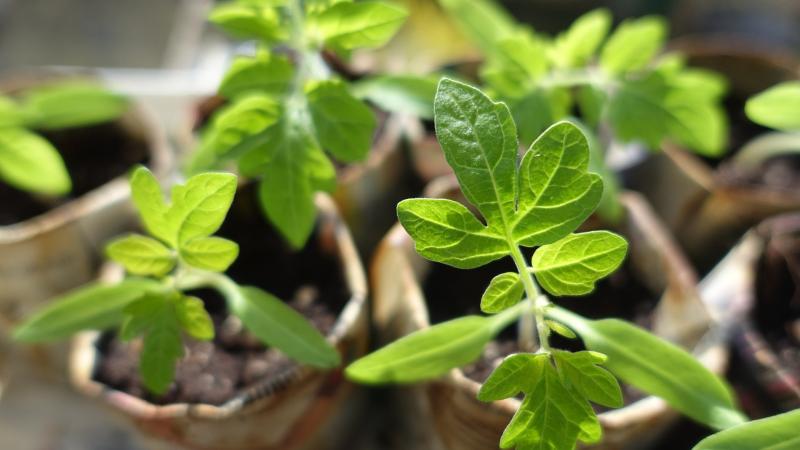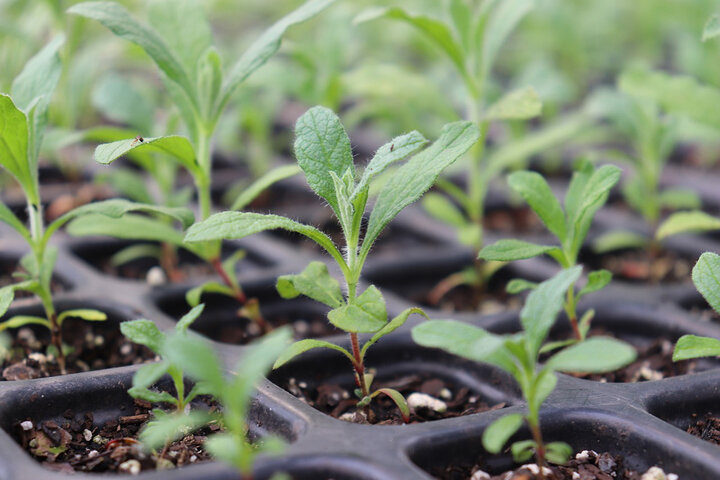Sarah Browning, Nebraska Extension Educator

Growing quality seedlings indoors requires high quality seeds.
For many home gardeners, it's fun to get a head start on the upcoming garden season by starting seedlings indoors. Growing quality seedlings indoors requires high quality seeds, a well-drained, disease-free growing medium, clean sanitized containers, proper temperature and moisture conditions, and adequate light. The best quality transplants are short, stocky and dark green.
Soil
The containers and growing medium must be free of disease organisms. The moist, warm conditions required for seed germination are also ideal for growth of fungi and other disease organisms.
The soil mix should be porous and also free of disease pathogens, which means no garden soil unless you’re willing to take the necessary steps to pasturize it.
The easiest option for home gardeners is to use a commercially prepared soilless media, such as Miracle Gro or Jiffy Mix.
Containers
Various containers can be used to germinate and grow transplants. Gardeners can purchase flats, trays, pots, compressed peat pellets, and other commercial products. Previously used flats, trays, and pots should be cleaned and disinfected before use.
For more ideas on using recycled materials for containers.
The size of the seeds largely determines the type of container and sowing method. Fine seeds, such as begonias and petunias, are typically sown in flats or trays scattered across the entire surface of the soil. After germination, the seedlings are transplanted into individual containers. Large seeds, such as marigolds and tomatoes, can also be germinated in flats. However, they are often sown directly into individual containers.

Sowing Seeds
When sowing seeds in flats or trays, fill the container with the growing medium to within 1/2 to 1 inch of the top. Firm the medium, water thoroughly, then allow it to drain. Fine seeds are usually dusted on the surface of the seedbed, then lightly pressed into the surface of the growing medium. Very small seeds can be mixed with a small amount of sand to make spreading them easier. Large seeds should be covered with growing medium to a thickness of one to two times their diameter.
Watering from below prevents the washing of seeds off the surface of the medium and prevents seeds from being buried too deeply in the soil through the movement of water. To do this, after sowing the seeds, place the seed pots in a larger tray or container of water. Allow water to wick up through the soil from beneath; this will take some time so be patient. When the surface becomes wet, remove the seed pots from the tray of water and allow them to drain.
When sowing seeds into individual containers, plant two or three seeds per container. Place the containers in a flat and water.
When to Start Your Seeds
The correct indoor sowing dates for several popular flowers and vegetables are:
- early March - cabbage, broccoli, and cauliflower;
- mid-March - pepper, eggplant, petunia, and salvia;
- late March - tomato, marigold, and zinnia;
- late April - muskmelon, watermelon, squash, and cucumber.
If unsure of the sowing date, check the seed packet.
Care During Germination Phase
To insure a uniform moisture level during germination, cover the seed flats with a clear plastic cover, or clear plastic wrap or place it in a clear plastic bag if a cover is not provided with your seed flat. Poke a few holes in the plastic wrap or bag to allow for some air circulation. The plastic conserves moisture and promotes quick germination. Once seedlings appear, the cover should come off to reduce the likelihood of damping-off, a fungal disease, and to keep seedlings from become spindly.
The medium must be kept moist but not sopping wet -- if it's allowed to dry out, germinating seeds may be killed. If seedlings get so dry that they wilt, their growth will be retarded for several days. Too much water is also a problem. Roots need air as well as water and they will not survive long in saturated soil.
Most flower seeds germinate best at a temperature of 75 degrees F. Though this is warmer than most people keep their houses, there are usually warmer spots such as on top of a refrigerator or above a heat register or radiator where warmer temperatures are available. Using heat cables under containers is another option.
Set the container in bright light, but out of direct sunlight. A medium temperature of 70 to 75 degrees F is adequate for the germination of most flowers and vegetables. Remove the plastic covering or bag as soon as germination occurs.
Care After Germination
Once the seeds have germinated, move the seedlings to an area with slightly cooler temperatures and direct sun or place under supplemental fluorescent or LED lights. Transplant the seedlings growing in flats into individual containers when the second pair of "true" leaves appear. Large-seeded plants that were sown two to three seeds per container should be thinned to one seedling per container. Destroy the weak seedlings by cutting them off with a razor blade.
For best results, grow seedlings under fluorescent or LED lights. A standard fluorescent shop fixture with two 40-watt tubes (one cool white and one warm white) works fine. The lights should be no more than 4 to 6 inches above the plants and on for 12 to 16 hours per day.
Thoroughly water the seedlings when the soil surface becomes dry to the touch. Fertilize weekly with a one-quarter strength houseplant fertilizer.
Hardening Off
Finally, harden or condition the seedlings outdoors for several days before planting them into the garden. Acclimate transplants to the outdoors by setting them outdoors on balmy spring days for gradually longer periods each time. They may dry out quickly, especially on breezy days, so check them often and water as needed. When the danger of frost is past, transplant them into the garden on a cloudy day or in the evening so they have a chance to recover somewhat from transplant shock before they have to cope with the full range of outdoor growing conditions.
Image by Pixabay.com.
Search Our Archive
Associated Video
Starting Seeds Tips
Nebraska Extension Assistant Mary Frogge talks about how to start seeds indoors